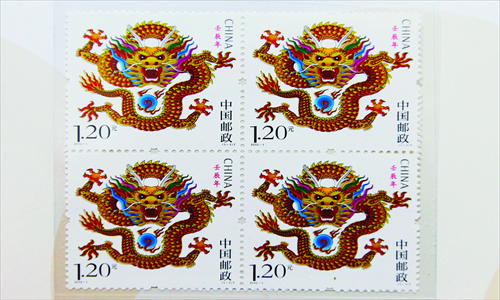Stamp of approval
A stamp buyer who spent one night queueing outside a post office in Shanghai to buy the first batch of dragon stamps, January 5. Photo: CFP
Not everyone approves of the design of China's dragon stamp to mark the new year. Although the design is inspired by the imprint of the imperial robe, it looks rather ferocious. But collectors and investors have been buying the stamp in huge quantities, and its price has risen by over 15 times in the month since it was released.
The face value of a page of 20 dragon stamps is 24 yuan ($3.8), but the price rose to 380 yuan Sunday, according to www.ybk001.com, a dedicated trading website for stamps, currencies and cards.
Local markets have also seen a surge in demand. "Almost half of the visitors recently have been looking for the dragon stamp," Yu Yangao, a trader at Madian currency, card and stamp market in Xicheng district, Beijing, told the Global Times. Madian market, which has nearly 1,000 stands, is the largest market of its kind in Asia.
China's postal authorities first released a stamp based on the Chinese Zodiac animal series in 1980 (a monkey stamp) and 2012 marks the third release since then of a dragon stamp.
Crash of '97
China's stamp market has seen surges and declines in value over the years, with 1997 seeing particularly heavy fluctuations.
In 1997, many people were attracted to the stamp market, and even relatively ordinary items started to be traded for hugely inflated prices. But when the market plunged in the second half of the year, people found it hard to sell the stamps they had bought.
The metal foil stamp commemorating the return of Hong Kong to the motherland was selling for 400 yuan per stamp in July, but a month later the price had fallen to 13 or 14 yuan, Zhou Fengchi, a stamp market analyst who has collected stamps for over 20 years, told the Global Times.
The Asian financial crisis was partly responsible for breaking the bubble in the stamp market, said Zhou. "Till today, many traders who spent millions of yuan that year on buying stamps are still in debt, having failed to cash in on their 1997 investment."
But since the end of 2010, the stamp market has seen a steady rise, partly due to high prices in the real estate market and meager returns in the stock market. "People realized the stamp market, which has been at a low level for over a decade, is a safer place to make profits," said Zhou.
2011 was also a good year, despite a slight cooling in mid-year and dips in the value of some types of stamps. The year saw a surge in prices for various types of zodiac animal stamps, as well as some military-themed ones and stamps released during the Cultural Revolution.

A boom year?
This year's stamp has done well, partly because of the traditional importance of the dragon in Chinese culture, said Yu Yan'gao. Many people bought the stamps for relatives or friends as gifts, he noted.
An employee surnamed Xu working for a Beijing stamp trading and designing company said that 2012 would be a boom year, driven by the dragon stamp.
"Dragon stamps brought much more attention to the market. And now, all the zodiac animal stamps are selling well, with the 2004 monkey stamp selling for around 700 yuan for a page of 20 this week," Xu told the Global Times.
March and April are a traditional busy season for the stamp market, as the weather turns warmer and more people begin walking outdoors. Although stamps can be bought online, most buyers prefer to go to markets as they need to check the look of the stamps, a crucial step in judging their value.
But Yu believes it will be hard for current prices to be maintained. "The festive period that helped stoke the market is over," he explained.
In Madian market, there are now few stands with a large stock of 2012 dragon stamps.
"Many traders, who made quick profits in the last round of price rises, are waiting for prices to drop before entering the market again," Zheng Min, another Beijing trader, told the Global Times.
The 1980 monkey stamp is still the most expensive zodiac animal stamp in today's market, with a price of up to 12,000 yuan per piece. The monkey stamp helped warm up the market by the huge profits it offered over last two years, an effect another stamp trader, Bai Haiwei, believed the 2012 dragon stamp "cannot achieve."
Circulation volume is one of the most important criteria for judging the value of a stamp. Unlike the 1980 monkey stamp, which had an issuance volume of over 4 million, around 50 million 2012 dragon stamps are expected to be issued, based on volumes of zodiac animal stamps released since 2006, said Bai.
Under the current post office policy, the issuance volume of a stamp will only be announced six months after its release.
Patience pays off
Guo Min, a 75-year-old stamp fan from Beijing, got up at 3 am on January 5 when the dragon stamp was released, only to find several hundred people already lined up in front of him.
"Most (of the buyers) were scalpers, who drove the price of the stamp higher and then peddled them for a price of 700 yuan a page, almost doubling the market price," Guo told the Global Times.
Besides scalpers, fakes have surfaced. The State Post Bureau of China, the watchdog of the stamp market, issued a warning on February 8, saying fake dragon stamps had been found, although they could be identified by rough printing and vague lines.
To ordinary collectors, it is "wise to wait for a period when prices (of the dragon stamp) become stable," Yu said.